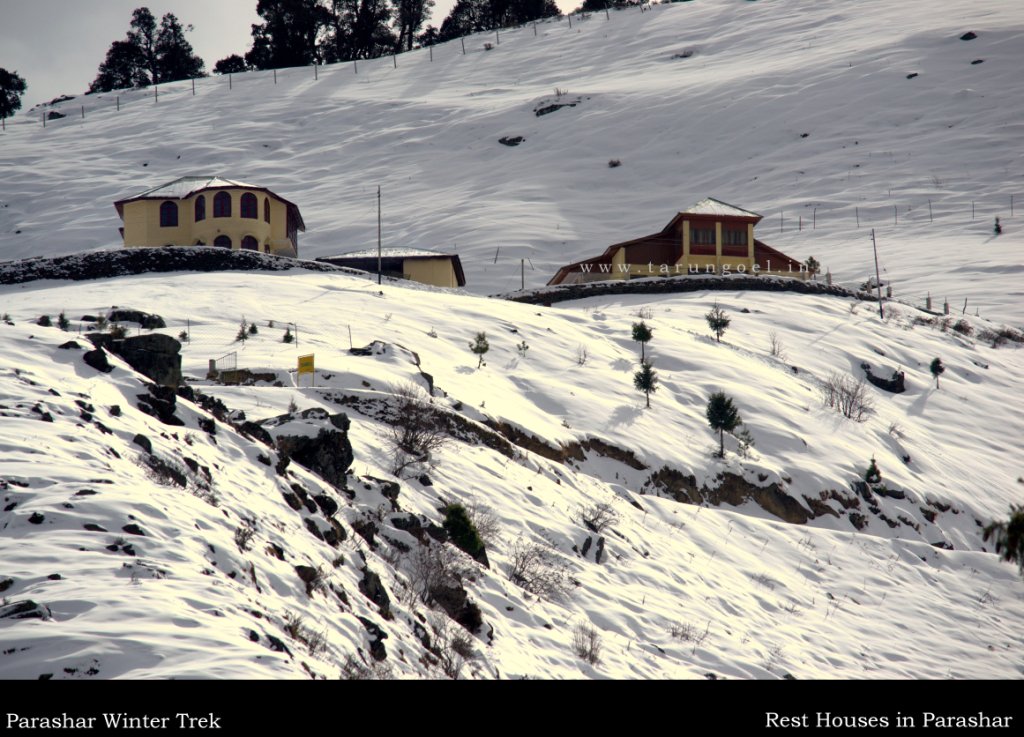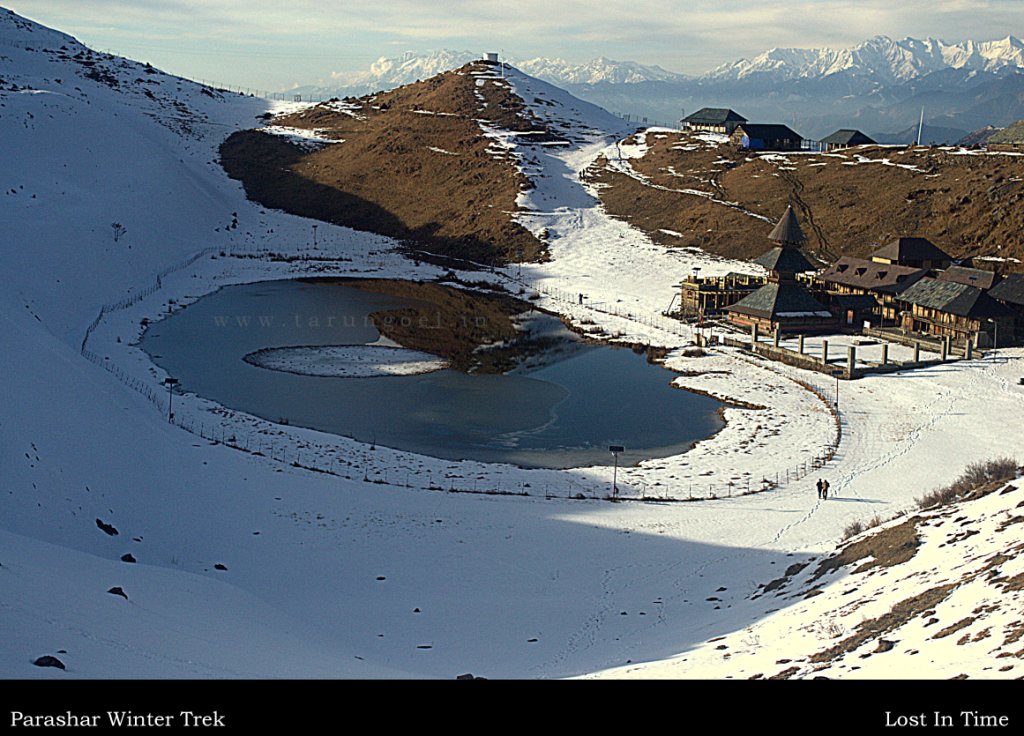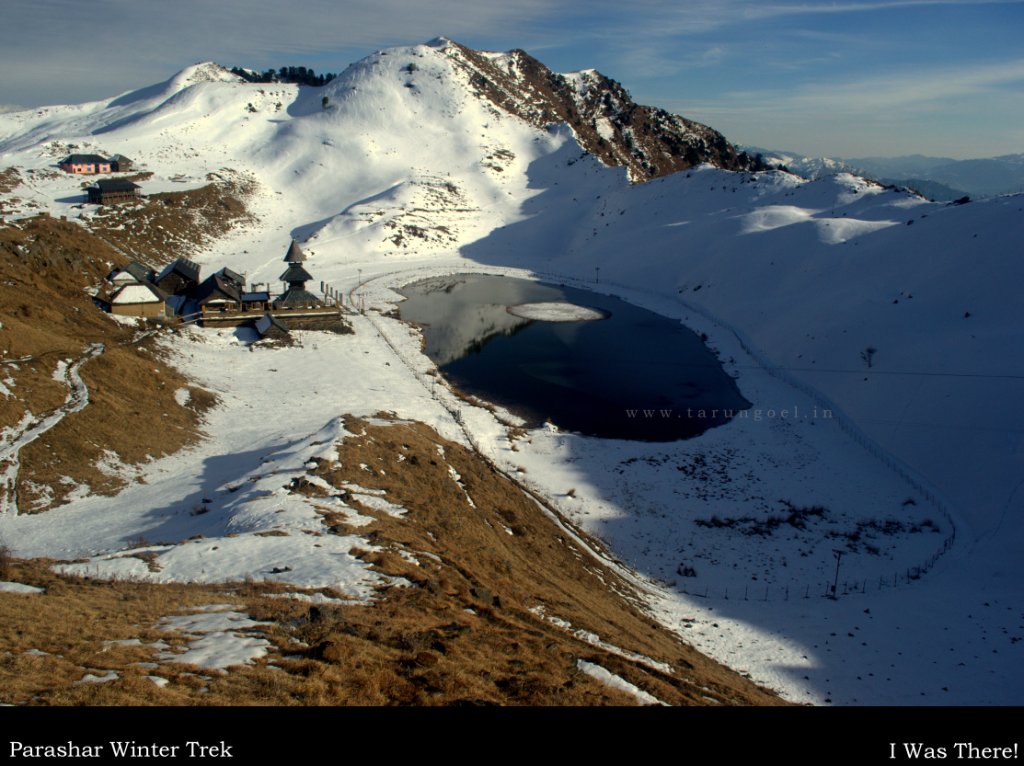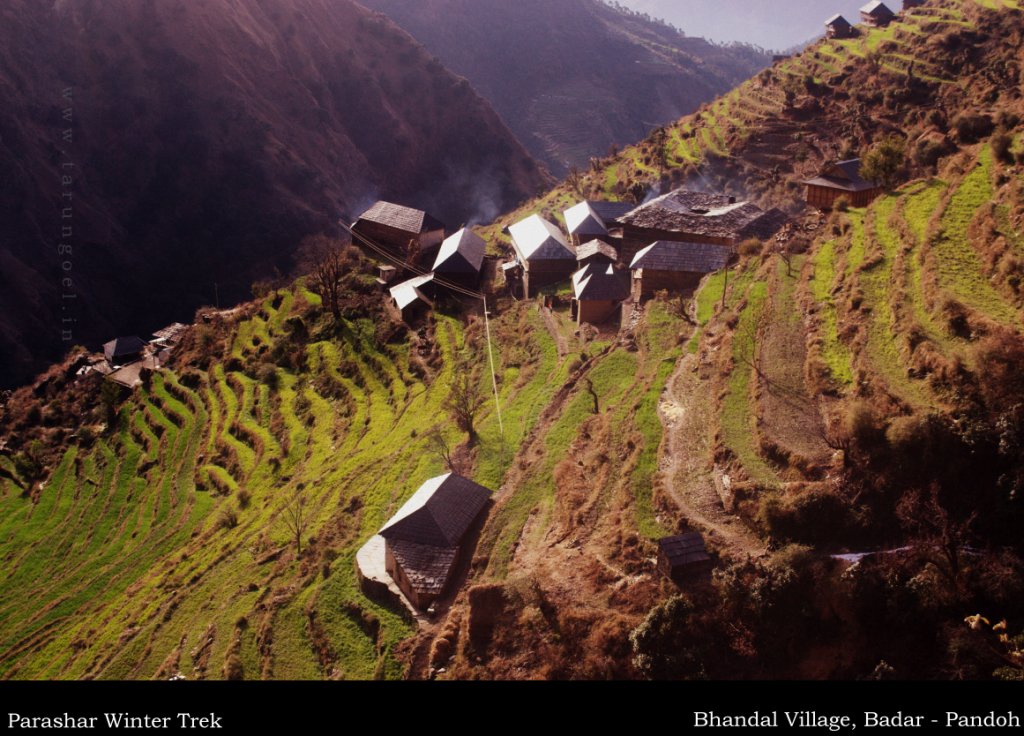My first journey to Parashar (2600 meters) was in the year 2006 when I was not aware of the word ‘Himalayas’. I had read about the Himalayas in my geography books but hey, who takes geography lessons seriously in the school. At least I did not!
Me and a friend of mine were so naïve that we carried only one blanket for us. We did not know about the existence of PWD or Forest rest house atop the lake. And as far as I remember, the PWD rest house wasn’t even functional back then. We slept on the floor of the ‘saray’ of the temple, frightened to the core at every movement and noise outside.

Snow Submerged Rest Houses at Parashar
That’s when I got to know about a trek route from Parashar to Pandoh (Badar Region) and Bajaura (Tunga Bhagwati temple). While the Tunga Bhagwati is 5 km North from the temple, the Pandoh town is 16 -18 km west from the temple. The trail to Pandoh Village is a well-marked trail that passes through beautiful villages and a thick forest. There are a couple of villages en-route which are not yet connected to the road. The trail to Pandoh meets the road-head at Deori village, which is another 5-7 km from Pandoh.
Tunga Bhagwati temple (3000 meters) is 5-6 km from the temple and often pilgrims from Kullu/ Bajaura tread on this path during the pilgrim season (June – July). On the opposite hill, in the southern direction, there is another small lake and a temple dedicated to Rishi Parashar’s wife, Majholi Mata it is known as. The lake remains dry for most of the times and its only during summers one can find water in the lake.
Getting down to Pandoh from Parashar (in winters) has its own advantages because a) the trail is practically free from snow as compared to the other side, b) Pandoh – Mandi is a National Highway and all it takes 20-25 minutes to reach Mandi, and c) the trail is an absolute gem of a walk.
Lake Parashar lies in the Uttarsal region while the area beyond the boundary of the Parashar Lake, to its western side belongs to the Badar region. The Uttarsal region starts near Kathindi – Kamand and stretches as far as Bajaura and borders with the Chuhar Valley (Barot et al.) on the eastern side. These names and region wise divisions date back to ancient times when the Kings and Emperors used to rule Mandi/Kullu. Other than these, there are few other ancient names and regions that are still prevalent even till date. Some of them are Lambri (near Saryolsar Lake), Snor (Mandi –Kullu road), and Seraj (Mandi – Kullu-Shimla border). The political constituencies are still defined by these boundaries and names.

Deo Tibba (6001 meters) – Extreme Right, Pir Panjals
The trek to Parashar in starts from Baagi Village, which is 10-12 km by road to Parashar. The first bus from Mandi starts between 0630 and 0700 Hours but its advised to check with the bus stand first (HRTC Mandi – 01905 23778). Frequency of buses often depends on the number of passengers; the vicious demand-supply cycle you see!

Snow Submerged Snow Parashar Lake

Parashar Temple
The next bus starts at 0815 hours but we could not get a seat on that because a team from IndiaHikes had booked the entire bus. In between, there is another bus at 7-7:30 that drops you at Kataula and then you can either take a cab to Baagi (INR 300-400) or walk or wait for the other bus to come.
The trail to Parahsar from Baagi has changed entirely from what it used to be in the first decade of the 2000s’. The water-mill at Baagi is gone now and you do not have to walk over huge slippery boulders anymore. A proper mule-track has been put in place. There was not much snow near Baagi but was all heavy fuel as we gained height. The snowline lasted for about 1/3rd of the journey.
The PWD and IPH guys can be seen working diligently round the clock. As we lost track, I asked two IPH guys about the directions. They were carrying a huge hoop of transmission wire on their shoulders, wrapped around their necks.
During winters, finding a bus from Baagi to Mandi is a herculean task and sometimes the cab owners too take you for the ride by charging exorbitantly. And that’s why getting down to Pandoh makes sense. It saves time. It saves money.
There are villages on this trail, like the Bhandal Village, perched over cliffs trying to have a discussion with a rivulet flowing downstream. There are small pagoda temples that are being renovated to give them a modern look (sic). There are primary schools where teachers walk as much as 10km to teach in a school of 40-50 students. There are terraced fields all around blossoming with mustard flowers and rhododendrons. And before you realize you hit the road-head at Deori Village. It’s a 3 km walk from Deori to the main road where from Pandoh is another 7km.

Bhandal Village – Badar Region

Pir Panjal Himalayas seen from Parashar Temple
There are two famous temples here in the Badar Region; the Shiva Badar and the Thatta Shukdev Rishi, both constructed in Pagoda Style. A visit is due!
Contact Details: Veer Singh FRH Parashar – 94591 – 37877 | Ram Singh PWD Parashar 94595 – 29024
P.S. There is a book written on the ‘Wooden Temples of Himachal Pradesh’ by Mian Goverdhan Singh. It gives intricate details about the temple architecture of Himachal Pradesh. You may read/buy it here, here and here.
Awesome Track Breathtaking Images and Nice narration!
Awesome .. Nicely penned down